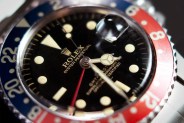Just as buying a used or vintage watch can feel daunting, selling one can be equally difficult for enthusiasts looking to reshape or downsize their collections. Watch nerds are a persnickety bunch, which means your timepiece will likely face heavy scrutiny before it is purchased. Leaving out crucial info, half-assing your photos or just directing your listing to the wrong audience can mean it’s not sold at all, or, at the very best, that it goes for a fraction of its true value.
Eric Wind is a veritable expert when it comes to the buying and selling of watches — he’s a former watch specialist at Christie’s who helped pioneer the auction house’s online watch sales and now works as an independent watch dealer. We asked his advice on how to get the most money for a vintage timepiece. His tips may seem fairly straightforward, but it’s often the little things that sellers tend to miss.
Step 1: Find the right platform.
There are several different avenues you can use to sell your watch, such as selling or consigning directly to dealers, consigning with auction houses or posting to online classifieds or forums. Not every one will work for every watch. “When I think through watches that I sold in the past purely as a collector versus having worked at Christie’s and now as a dealer, I think people need to think through each watch and which will be the best way to sell it,” Wind says.
Ideally, you should have a good idea of your watch’s value (viewing completed auctions for similar watches on eBay or at auction houses like Christie’s or Sotheby’s is helpful) and use that as a starting point. “For lower value watches, like $1,000 and under, it doesn’t make sense to list them at an auction house or anything like that. It’s easy to post them on ChronoTrader or throw it on eBay,” says Wind. But when watches are particularly rare or unique, that’s when going through an auction house is the better route because “there will be competition.”
For watches that are somewhere in the middle — valuable, but still relatively common — Wind suggests selling to or consigning with a dealer. The problem here is that in exchange for making a quick and easy sale, you’ll likely make less than what the watch is actually worth. If you want to make as much money as you can, setting up a listing on the most suitable enthusiast forum, like Rolex Forums, Omega Forums or WatchUSeek, or simply selling on a watch classified site like Chrono24 is the way to go. (Editor’s Note: WatchRecon will aggregate many of the posts from these different forums, making for an easy way to scan through them all in one place.)


